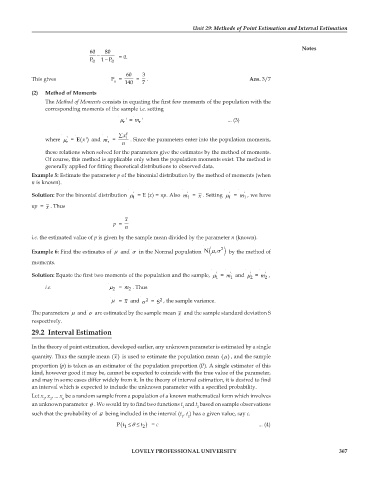Page 372 - DECO504_STATISTICAL_METHODS_IN_ECONOMICS_ENGLISH
P. 372
Unit 29: Methods of Point Estimation and Interval Estimation
Notes
60 − 80
P 0 1 − P 0 = 0.
60 3
This gives P = = . Ans. 3/7
0 140 7
(2) Method of Moments
The Method of Moments consists in equating the first few moments of the population with the
corresponding moments of the sample i.e. setting
μ ' = m r ' ... (3)
r
∑x r
'
'
where μ = () 'x and m = n i . Since the parameters enter into the population moments,
E
r
r
these relations when solved for the parameters give the estimates by the method of moments.
Of course, this method is applicable only when the population moments exist. The method is
generally applied for fitting theoretical distributions to observed data.
Example 5: Estimate the parameter p of the binomial distribution by the method of moments (when
n is known).
'
'
'
'
Solution: For the binomial distribution μ = E (x) = np. Also m = x . Setting μ = m , we have
1
1
1
1
np = x . Thus
x
p =
n
i.e. the estimated value of p is given by the sample mean divided by the parameter n (known).
Example 6: Find the estimates of μ and σ in the Normal population ( μ σN , 2 ) by the method of
moments.
'
'
'
'
Solution: Equate the first two moments of the population and the sample, μ = m and μ = m ,
2
1
2
1
i.e. μ 2 = m . Thus
2
2
2
μ = x and σ = S , the sample variance.
The parameters μ and σ are estimated by the sample mean x and the sample standard deviation S
respectively.
29.2 Interval Estimation
In the theory of point estimation, developed earlier, any unknown parameter is estimated by a single
quantity. Thus the sample mean ( ) x is used to estimate the population mean () μ , and the sample
proportion (p) is taken as an estimator of the population proportion (P). A single estimator of this
kind, however good it may be, cannot be expected to coincide with the true value of the parameter,
and may in some cases differ widely from it. In the theory of interval estimation, it is desired to find
an interval which is expected to include the unknown parameter with a specified probability.
Let x , x , ... x be a random sample from a population of a known mathematical form which involves
1 2 n
an unknown parameter θ . We would try to find two functions t and t based on sample observations
1 2
such that the probability of θ being included in the interval (t , t ) has a given value, say c.
1 2
(
θ
P t ≤≤ t 2 ) 1 = c ... (4)
LOVELY PROFESSIONAL UNIVERSITY 367

